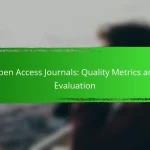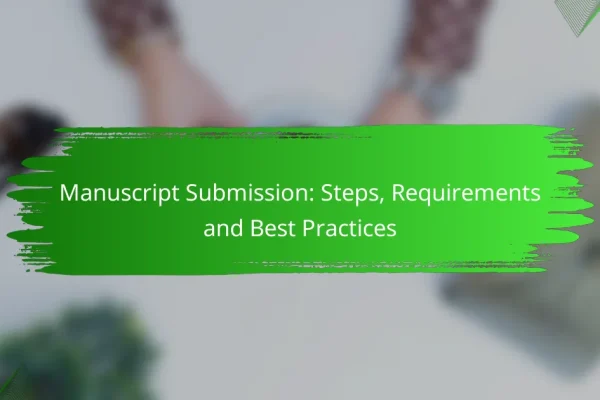What are the key steps in the publishing process for academic journals?
The publishing process for academic journals typically involves three main steps: submission of the manuscript, peer review, and final decision followed by publication. Understanding these stages helps authors navigate the complexities of getting their research published.
Submission of manuscript
The submission of a manuscript is the initial step where authors send their research paper to a journal. This usually involves creating an account on the journal’s submission platform and uploading the manuscript along with any required supplementary materials, such as figures or data sets.
Authors should carefully follow the journal’s submission guidelines, which outline formatting, length, and citation style requirements. Failing to adhere to these guidelines can lead to delays or outright rejection.
Peer review process
Once submitted, the manuscript enters the peer review process, where it is evaluated by experts in the field. This stage typically takes several weeks to months, depending on the journal and the availability of reviewers.
Reviewers assess the manuscript for originality, validity, and significance. Authors may receive feedback that requires revisions, which they must address before the manuscript can proceed. It’s essential to respond to reviewer comments thoroughly and respectfully to improve the chances of acceptance.
Final decision and publication
After the peer review, the journal editor makes a final decision, which can be acceptance, minor revisions, major revisions, or rejection. If accepted, the manuscript moves into the publication phase, which includes typesetting, proofreading, and final approval from the authors.
Publication timelines can vary widely, often ranging from a few months to over a year after acceptance. Authors should stay in communication with the journal to ensure they are aware of any updates or required actions during this period.
How do I choose the right academic journal for my research?
Choosing the right academic journal for your research involves understanding the journal’s focus, audience, and reputation. Consider factors such as the journal’s scope, impact factor, and how well it aligns with your work to ensure your research reaches the appropriate audience.
Journal scope and audience
The scope of a journal refers to the topics and fields it covers. It’s essential to select a journal that aligns closely with your research area to increase the chances of acceptance and readership. Review the journal’s aims and scope statement, typically found on its website, to determine if your work fits.
Additionally, consider the audience of the journal. Some journals cater to specialists in a specific field, while others target a broader academic community. Understanding who reads the journal can help you tailor your manuscript to meet their expectations and interests.
Impact factor and reputation
The impact factor is a measure of how often articles in a journal are cited, reflecting its influence within the academic community. While a higher impact factor can indicate a more prestigious journal, it is not the only measure of quality. Evaluate the journal’s reputation in your specific field, as some niche journals may have significant influence despite lower impact factors.
When assessing a journal’s reputation, consider factors such as editorial board composition, indexing in major databases, and feedback from colleagues. Aim for a balance between impact factor and relevance to your research to maximize visibility and credibility.
What are common challenges faced during the publishing process?
Common challenges in the publishing process of academic journals include rejection, addressing reviewer comments, and navigating the submission guidelines. Authors often find these hurdles daunting, as they can significantly delay the publication of their research.
Rejection and resubmission
Rejection is a frequent occurrence in academic publishing, with many journals rejecting a substantial percentage of submissions. Authors should be prepared for this possibility and view rejection as an opportunity to improve their work. Resubmission to the same or a different journal may require significant revisions based on feedback or a complete overhaul of the manuscript.
To enhance the chances of acceptance, authors should carefully read the journal’s scope and submission guidelines before submitting. Tailoring the manuscript to fit the journal’s audience and standards can help reduce the likelihood of rejection.
Addressing reviewer comments
Reviewer comments are a critical part of the publishing process, providing valuable insights that can strengthen a manuscript. Authors should approach these comments constructively, taking time to understand each point raised by reviewers. A well-organized response to reviewer feedback can significantly improve the chances of acceptance upon resubmission.
When addressing comments, it’s helpful to create a detailed response letter that outlines how each point was addressed in the revised manuscript. This not only shows respect for the reviewers’ efforts but also demonstrates the author’s commitment to improving their work. Common pitfalls include dismissing reviewer suggestions or failing to provide clear explanations for any changes made.
What criteria should I consider when preparing my manuscript?
When preparing your manuscript for submission to an academic journal, consider the journal’s specific requirements, including formatting, style, and scope. Adhering to these criteria increases the likelihood of acceptance and facilitates the review process.
Formatting guidelines
Each academic journal has its own formatting guidelines that dictate how your manuscript should be structured. Common elements include font type and size, margin specifications, line spacing, and section headings. For instance, many journals prefer a 12-point Times New Roman font with double spacing and one-inch margins.
Check the journal’s website for a detailed author guideline document, which often includes templates. Following these guidelines closely can prevent delays in the review process and ensure your work is presented professionally.
Reference management
Effective reference management is crucial in academic writing. Use citation management tools like EndNote, Mendeley, or Zotero to organize your references and format them according to the required style, such as APA, MLA, or Chicago. These tools can save time and reduce errors in your bibliography.
Ensure that all citations in your manuscript are complete and correspond to the references listed at the end. Many journals require a specific number of recent sources, so aim to include a mix of foundational texts and current research to support your arguments.
How do open access journals differ from traditional journals?
Open access journals provide free access to their articles, while traditional journals typically require a subscription or payment for access. This fundamental difference affects how research is disseminated and accessed by the public and academic communities.
Access and availability
Open access journals allow anyone to read and download articles without any financial barriers, promoting wider dissemination of research. In contrast, traditional journals often restrict access to subscribers or institutions, limiting the audience to those who can afford the fees.
This difference in access can significantly impact the visibility and citation rates of research. Studies suggest that articles in open access journals tend to receive more citations due to their broader availability.
Publication fees
Open access journals typically charge authors publication fees, which can range from a few hundred to several thousand dollars, depending on the journal’s reputation and reach. These fees cover the costs of editorial services, peer review, and online hosting.
Traditional journals may not charge authors directly but instead rely on subscription fees from libraries and individuals. Authors should consider the financial implications of publication fees when choosing where to submit their work, as some institutions may have funding available for open access fees.
What are the emerging trends in academic publishing?
Emerging trends in academic publishing include increased use of preprints, a focus on data sharing and transparency, and the integration of AI in manuscript evaluation. These trends aim to enhance accessibility, improve research quality, and streamline the publishing process.
Increased use of preprints
Preprints are becoming a popular way for researchers to share their findings before formal peer review. This practice allows for faster dissemination of knowledge and encourages collaboration among scholars. Many fields, particularly in the sciences, have seen preprint servers gain traction, enabling authors to receive feedback and improve their work prior to submission to journals.
However, researchers should be aware that posting a preprint may affect their ability to publish in certain journals, as some have policies regarding prior dissemination. It is essential to check the journal’s guidelines before uploading a preprint.
Data sharing and transparency
Data sharing is increasingly emphasized in academic publishing, with many journals now requiring authors to make their datasets publicly available. This trend promotes transparency and allows other researchers to validate findings or build upon existing work. Open data practices can enhance the credibility of research and foster a culture of collaboration.
To effectively share data, researchers should consider using established repositories that comply with relevant standards, such as the FAIR principles (Findable, Accessible, Interoperable, Reusable). Proper documentation and metadata are crucial for ensuring that shared data can be understood and utilized by others.
AI in manuscript evaluation
The integration of AI in manuscript evaluation is transforming the peer review process. AI tools can assist in identifying potential reviewers, checking for plagiarism, and even evaluating the quality of the manuscript. This technology aims to reduce the time taken for reviews and enhance the overall efficiency of the publishing process.
While AI can streamline certain aspects, it is important to remember that human judgment remains essential in assessing the nuances of research. Researchers should remain engaged in the review process and provide clear, constructive feedback to ensure high-quality outcomes.







